Please download PDF from the button above for all other contents for the following currencies.
Australian dollar // New Zealand dollar //Canadian dollar // Norwegian krone // Swedish Krona // Swiss franc // Czech koruna // Hungarian forint //Polish zloty // Romanian leu // Russian rouble // South African rand // Turkish lira // Indian rupee // Indonesian rupiah // Malaysian ringgit // Philippine peso //Singapore dollar // South Korean won // Taiwan dollar // Thai baht // Vietnamese dong // Argentine peso // Brazilian real // Chilean peso // Mexican peso // Crude oil // Saudi riyal // Egyptian pound
Monthly Foreign Exchange Outlook
DEREK HALPENNY
Head of Research, Global Markets EMEA and International Securities
Global Markets Research
Global Markets Division for EMEA
E: derek.halpenny@uk.mufg.jp
LEE HARDMAN
Senior Currency Analyst
Global Markets Research
Global Markets Division for EMEA
E: lee.hardman@uk.mufg.jp
LIN LI
Head of Global Markets Research Asia
Global Markets Research
Global Markets Division for Asia
E: lin_li@hk.mufg.jp
MICHAEL WAN
Senior Currency Analyst
Global Markets Research
Global Markets Division for Asia
E: michael_wan@sg.mufg.jp
EHSAN KHOMAN
Head of Commodities, ESG and Emerging Markets Research – EMEA
DIFC Branch – Dubai
E: ehsan.khoman@ae.mufg.jp
CARLOS PEDROSO
Chief Economist
Banco MUFG Brasil S.A.
E: cpedroso@br.mufg.jp
MAURICIO NAKAHODO
Senior Economist
Banco MUFG Brasil S.A.
E: mnakahodo@br.mufg.jp
MUFG Bank, Ltd.
A member of MUFG, a global financial group
August 2023
KEY EVENTS IN THE MONTH AHEAD
1) WILL THE FED SIGNAL RATE HIKE PAUSE AT JACKSON HOLE
The US dollar weakened in July by -1.0% (DXY) as it briefly fell to a fresh year to date low below the 100.00-level for the first time since April of last year. The renewed leg lower for the US dollar was driven by building evidence of slowing US inflation. It has given market participants more confidence that the Fed will not have to keep raising rates further into restrictive territory which is helping to boost investor optimism over a softer landing for the US economy. At the Fed’s latest policy meeting, Chair Powell signalled that future policy decisions will be data dependent rather than reiterating previous plans to hike rates again later this year. Needless to say the incoming data in the month ahead including CPI, PCE deflator and PPI reports for July will take on even more importance in assessing whether the July hike will be the last in the Fed’s tightening cycle. The annual Jackson Hole symposium at the end of August could provide the earliest opportunity for the Fed to signal a pause.
2) BOE TO SIGNAL IT STILL HAS WORK TO DO
The next major central bank to update policy settings will be the BoE in the week ahead. Unlike the ECB and Fed who signalled at their last policy meeting that they are close to the end of their hiking cycles, the BoE remains in a more challenging situation when setting policy. Inflation in the UK has not slowed as much as in the euro-zone or in the US even though the weaker June CPI report provided some relief. We expect the BoE to revert back to delivering another smaller 25bps hike this month, and to continue to signal concern over the risk of more persistent inflation in the UK. The BoE will leave the door open to further hikes later this year unless inflation begins to slow more quickly than expected and/or there is evidence that the UK economy is beginning to be more negatively impacted by higher rates. The full impact of higher rates has yet to be felt with the monetary transmission lag expected to be longer than in previous economic cycles.
3) GOVERNMENT STIMULUS ROLL-OUTS ARE KEY TO WATCH
While China July macro numbers may continue to be weak and possibly surprise the market to the downside, this is unlikely to play a large role in deciding CNY movement in the near term. The focus of the market will be on the roll-out of the policy stimulus by the central government and local governments. In the past few days, we saw that cities like Beijing and Shenzhen vowed to ease property restrictions, to follow through on the Politburo’s pledge to stabilize China’s property sector. We expect more of such follow-ups will happen, and will prove important in evaluating China’s growth and the performance of CNY.
Forecast rates against the US dollar - End-3 2023 to End-Q2 2024
|
Spot close 31.07.23 |
Q3 2023 |
Q4 2023 |
Q1 2024 |
Q2 2024 |
|
|
JPY |
142.13 |
138.00 |
136.00 |
134.00 |
132.00 |
|
EUR |
1.1028 |
1.1000 |
1.1200 |
1.1300 |
1.1000 |
|
GBP |
1.2864 |
1.2870 |
1.2950 |
1.2770 |
1.2360 |
|
CNY |
7.1440 |
7.0000 |
6.8000 |
6.7000 |
6.6000 |
|
AUD |
0.6735 |
0.6700 |
0.6900 |
0.6800 |
0.6600 |
|
NZD |
0.6221 |
0.6100 |
0.6200 |
0.6100 |
0.5900 |
|
CAD |
1.3151 |
1.3100 |
1.3200 |
1.3300 |
1.3400 |
|
NOK |
10.100 |
10.091 |
9.8210 |
9.6460 |
9.8180 |
|
SEK |
10.484 |
10.545 |
10.268 |
10.088 |
10.273 |
|
CHF |
0.8684 |
0.8770 |
0.8660 |
0.8670 |
0.8820 |
|
|
|
|
|
|
|
|
CZK |
21.649 |
21.820 |
21.430 |
21.060 |
21.450 |
|
HUF |
350.67 |
354.50 |
352.70 |
354.00 |
368.20 |
|
PLN |
3.9900 |
4.0000 |
3.9730 |
3.9820 |
4.1820 |
|
RON |
4.4719 |
4.5000 |
4.4380 |
4.4250 |
4.5820 |
|
RUB |
91.577 |
93.780 |
94.880 |
96.360 |
99.520 |
|
ZAR |
17.803 |
18.000 |
18.250 |
18.500 |
19.000 |
|
TRY |
26.926 |
28.500 |
30.000 |
31.000 |
31.000 |
|
|
|
|
|
|
|
|
INR |
82.248 |
81.500 |
80.500 |
79.500 |
79.000 |
|
IDR |
15075 |
15000 |
14800 |
14600 |
14400 |
|
MYR |
4.5050 |
4.5000 |
4.4000 |
4.3000 |
4.2000 |
|
PHP |
54.870 |
54.500 |
54.000 |
53.500 |
53.000 |
|
SGD |
1.3280 |
1.3200 |
1.3050 |
1.2900 |
1.2800 |
|
KRW |
1274.2 |
1260.0 |
1240.0 |
1220.0 |
1200.0 |
|
TWD |
31.445 |
30.750 |
30.500 |
30.250 |
30.000 |
|
THB |
34.106 |
33.600 |
33.000 |
32.500 |
32.000 |
|
VND |
23687 |
23650 |
23600 |
23550 |
23500 |
|
|
|
|
|
|
|
|
ARS |
275.25 |
310.00 |
378.00 |
475.00 |
500.00 |
|
BRL |
4.7453 |
4.9000 |
5.2000 |
5.2200 |
5.2500 |
|
CLP |
841.08 |
835.00 |
840.00 |
825.00 |
805.00 |
|
MXN |
16.734 |
16.900 |
17.200 |
17.500 |
17.800 |
|
|
|||||
|
Brent |
85.54 |
80.00 |
84.00 |
83.00 |
81.00 |
|
NYMEX |
81.58 |
76.00 |
79.00 |
78.00 |
77.00 |
|
SAR |
3.7515 |
3.7500 |
3.7500 |
3.7500 |
3.7500 |
|
EGP |
30.884 |
32.200 |
32.500 |
33.900 |
34.800 |
Notes: All FX rates are expressed as units of currency per US dollar bar EUR, GBP, AUD and NZD which are expressed as dollars per unit of currency. Data source spot close; Bloomberg closing rate as of 4:30pm London time, except VND which is local onshore closing rate.
US dollar
|
Spot close 31.07.23 |
Q3 2023 |
Q4 2023 |
Q1 2024 |
Q2 2024 |
|
|
USD/JPY |
142.13 |
138.00 |
136.00 |
134.00 |
132.00 |
|
EUR/USD |
1.1028 |
1.1000 |
1.1200 |
1.1300 |
1.1000 |
|
Range |
Range |
Range |
Range |
||
|
USD/JPY |
135.00-146.00 |
133.00-144.00 |
131.00-142.00 |
129.00-140.00 |
|
|
EUR/USD |
1.0500-1.1400 |
1.0600-1.1600 |
1.0700-1.1700 |
1.0400-1.1500 |
MARKET UPDATE
In July the US dollar weakened against the euro in terms of London closing rates, moving from 1.0913 to 1.1028. In addition, the dollar weakened versus the yen, from 144.57 to 142.13. The FOMC raised the federal funds rate to between 5.25 and 5.50% in July. The FOMC has continued with its policy of reducing its securities holdings with QT ongoing at a pace of USD 95bn worth of UST bonds (USD 60bn) and MBS (USD 35bn) of balance sheet reduction each month. However, this was dramatically offset by balance sheet expansion to provide loans and liquidity for the banking sector after the turmoil in March.
OUTLOOK
The US dollar weakened further in July as it fell to fresh year to date lows. The dollar index briefly fell below the 100.00-level for the first time since April of last year as the sell-off that began in autumn of last year continues to extend. It still leaves the dollar index around 6.0% higher than levels recorded prior to the start of the Ukraine conflict in early 2022. The reversal of last year’s US dollar rally gathered fresh momentum in the first half of July triggered by building evidence of slowing US inflation. The recent slowdown has become more evident in the core inflation measures that the Fed has been watching closely and is not just driven by lower food and energy prices. Core services inflation less housing, the so-called super core measure, has been much weaker in May and June. It has helped to ease fears that higher inflation will prove persistent although the Fed is not yet ready to signal that rates have been raised sufficiently to bring inflation back to target. At the July FOMC press conference Chair Powell emphasised that future policy decisions will be data dependent. Further evidence of slowing US inflation in the coming months should encourage the Fed to signal a pause to the hiking cycle at either the Jackson Hole symposium at the end of August or at the September FOMC meeting.
The US dollar has continued to weaken even as the US economy has proven more resilient to higher rates and tightening credit conditions than expected. It was confirmed that the US economy expanded by an annualized rate of 2.4% in Q2 and by an average of 2.2% in the 1H of this year. The combination of slowing US inflation and better than expected activity data is boosting investor optimism over a softer landing for the US economy. It would still leave room for the Fed to lower rates and make monetary policy less restrictive next year if inflation continues to slow.
In these circumstances, we expect the US dollar to weaken further through the rest of this year. The main risk to our view would be if US inflation proves more sticky than expected thereby limiting room for Fed cuts, and/or if the US economy becomes too hot or too cold. In our forecast profile, we show the US dollar beginning to rebound in the 1H of next year to reflect the risk of a sharper US/global slowdown in response to tighter monetary policy that boosts demand for safe havens such as the US dollar.
INTEREST RATE OUTLOOK
|
Interest Rate Close |
Q3 2023 |
Q4 2023 |
Q1 2024 |
Q2 2024 |
|
|
Policy Rate |
5.33% |
5.38% |
5.13% |
4.63% |
3.88% |
|
3-Month T-Bill |
5.40% |
5.40% |
5.13% |
4.50% |
3.63% |
|
10-Year Yield |
3.96% |
4.13% |
3.75% |
3.63% |
3.50% |
* Interest rate assumptions incorporated into MUFG foreign exchange forecasts.
The Fed hiked rates for the 11th time, bringing up the Fed Funds target rate (FFR) range to 5.25-5.50%. And the Fed still has another potential hike in store for 2023 if we take their dots forecasts as guidance. Chair Powell during the press conference emphasized that there are 2 more inflation and jobs reports before the next meeting and that they are not ready to signal moving to an alternating hiking path (which would imply that they would hike only at the November meeting). Therefore, September could still be a live meeting while they wait and see if jobs data remains strong and CPI sticky. Given that the Fed is in a data-dependent mode, if the data proves robust through the September FOMC, the risk is they deliver a back-to-back 25bp hikes again. If the Fed hikes again and there are no credit events between now and year-end, we will revisit our rate forecasts and adjust as needed. However, for now we are not changing our rates path for Fed Funds as we believe long and variable lags will hit the economy hard in the second half into early 2024. The near-term risk is that 10yr rates move higher on the back of higher supply and BoJ YCC tweaks weighing on markets. (George Goncalves, US Macro Strategy)
HEADLINE VS. CORE INFLATION
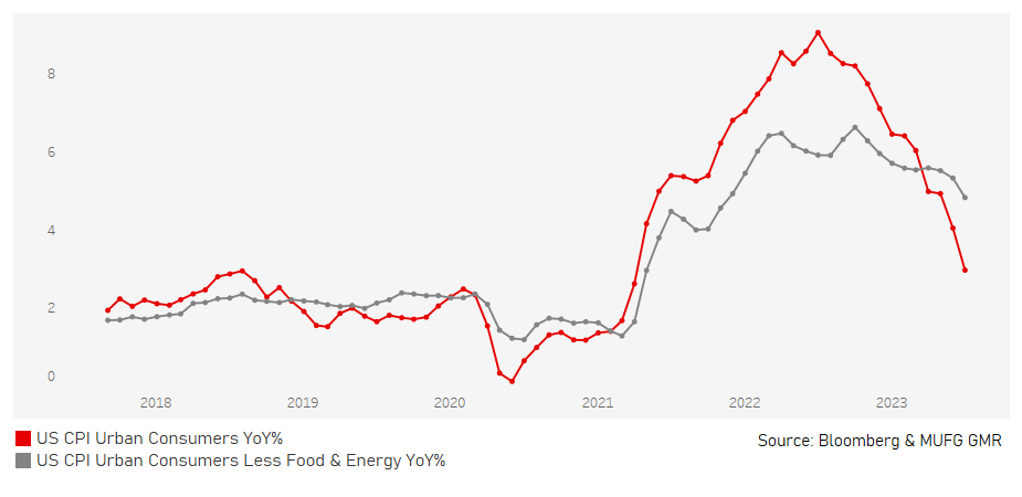
CREDIT CONDITIONS FOR US FIRMS

Japanese yen
|
Spot close 31.07.23 |
Q3 2023 |
Q4 2023 |
Q1 2024 |
Q2 2024 |
|
|
USD/JPY |
142.13 |
138.00 |
136.00 |
134.00 |
132.00 |
|
EUR/JPY |
156.74 |
151.80 |
152.30 |
151.40 |
145.20 |
|
Range |
Range |
Range |
Range |
||
|
USD/JPY |
135.00-146.00 |
133.00-144.00 |
131.00-142.00 |
129.00-140.00 |
|
|
EUR/JPY |
148.00-161.00 |
146.00-159.00 |
144.00-157.00 |
142.00-155.00 |
MARKET UPDATE
In July the yen strengthened versus the US dollar in terms of London closing rates from 144.57 to 142.13. In addition, the yen strengthened marginally versus the euro, from 157.77 to 156.74. The BoJ at its meeting in July decided to conduct yield curve control with greater flexibility. The BoJ will continue to allow 10-year JGB yields to fluctuate in the range of around +/- 0.5% from the target level of 0.0%. However, the upper and lower bounds of the range are now viewed as “references” and not as “rigid limits”. The BoJ will offer to purchase 10-year JGBs at 1.0% every business day through though fixed-rate purchase operations. At the same time, the BoJ reiterated that it will continue to apply a negative policy rate of -0.1%.
OUTLOOK
The BoJ adjusted YCC settings at their latest policy meeting in July as we had anticipated. The shift to more flexible policy settings for YCC has allowed more room for the 10-year JGB yield to adjust higher beyond the previous hard cap at 0.5%. It has already resulted in the 10-year JGB yield rising to its highest level since the 1H 2014. While the BoJ is loosening its control of JGB yields, it still plans to “nimbly” conduct market operations when the 10-year yield is trading between 0.5% and 1.0%, and will impose a new hard cap at 1.0% through fixed-rate purchase operations. The BoJ has already stepped back into the market to smooth the move higher in JGB yields since the policy meeting. The next logical policy step would be for the BoJ to gradually fade out YCC through the rest of this year.
While the BoJ’s decision to adjust YCC settings initially triggered a rebound for the yen resulting in USD/JPY falling back close to the 138.00-level, those initial gains proved to be short-lived. The modest move higher in long-term yields in Japan has not yet been sufficient to discourage yen funded carry trades. The BoJ’s communication has helped to dampen upside risks for the yen in the near-term. Governor Ueda emphasized that the adjustment to YCC settings was mainly intended to make policy easing more sustainable and it should not be viewed as tightening policy. The BoJ sent a clear signal that it is not yet seriously considering tightening policy through raising interest rates given that it is not confident that inflation can be sustained at their 2.0% target. The BoJ’s updated projections still showed that it forecast Japanese style core inflation falling back to 1.6% by FY2025. As a result, we do not expect the BoJ to begin raising rates out of negative territory until the 1H of next year when there is more evidence of stronger wage growth.
In these circumstances, we still expect the yen to strengthen in the year ahead although the likelihood of a rebound in the near-term has diminished after it failed to hold on to initial gains after the BoJ’s latest policy update. Furthermore investor fears over a hard landing for the US and global economies have eased. In the year ahead, we expect the BoJ policy to tighten policy and for yields outside of Japan to fall both encouraging the yen to rebound from deeply undervalued levels.
INTEREST RATE OUTLOOK
|
Interest Rate Close |
Q3 2023 |
Q4 2023 |
Q1 2024 |
Q2 2024 |
|
|
Policy Rate |
-0.10% |
-0.10% |
-0.10% |
-0.10% |
0.00% |
|
3-Month Bill |
-0.10% |
-0.10% |
-0.10% |
-0.05% |
0.10% |
|
10-Year Yield |
0.61% |
0.70% |
0.60% |
0.50% |
0.50% |
* Interest rate assumptions incorporated into MUFG foreign exchange forecasts.
The 10-year JGB yield increased sharply by 21bps to close at 0.61% in July. The sharp move higher in the 10-year JGB yield was driven both by speculation of a change in BoJ policy settings in the run up to the July policy meeting, and then by confirmation that the BoJ had decided to make YCC policy settings more flexible. As outlined on the previous page, the BoJ will now allow the 10-year JGB yield to rise above 0.5% up to a new hard cap of 1.0% set by fixed-rate purchase operations. The BoJ will also “nimbly” conduct market operations when the 10-year JGB yield is trading between 0.5% and 1.0%. The BoJ has already intervened since the policy announcement to help smooth the move higher in JGB yields. We expect the 10-year JGB yield to head higher in the near-term but without reaching the new hard cap at 1.0%. It is in line with the view expressed by Governor Ueda in the press conference. If yields begin to stabilize between 0.5% and 1.0%, the BoJ will be encouraged to remove YCC. Beyond the near-term we expect the 10-year JGB yield to revert lower alongside other major global yields driven by slowing inflation and weak growth.
10-YEAR JGB YIELD VS. YCC POLICY SETTINGS
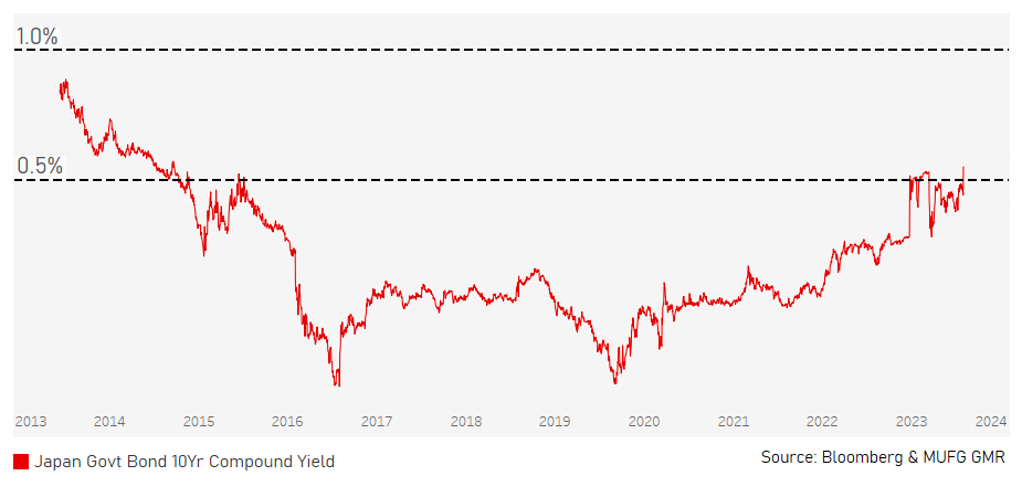
MARKET OPERATIONS BY THE BANK OF JAPAN (OUTRIGHT PURCHASES)
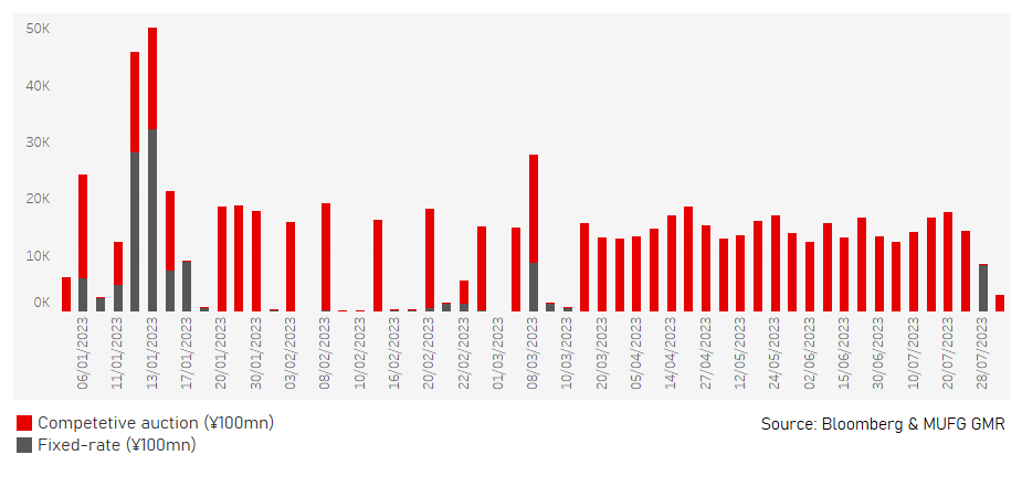
Euro
|
Spot close 31.07.23 |
Q3 2023 |
Q4 2023 |
Q1 2024 |
Q2 2024 |
|
|
EUR/USD |
1.1028 |
1.1000 |
1.1200 |
1.1300 |
1.1000 |
|
EUR/JPY |
156.74 |
151.80 |
152.30 |
151.40 |
145.20 |
|
Range |
Range |
Range |
Range |
||
|
EUR/USD |
1.0500-1.1400 |
1.0600-1.1600 |
1.0700-1.1700 |
1.0400-1.1500 |
|
|
EUR/JPY |
148.00-161.00 |
146.00-159.00 |
144.00-157.00 |
142.00-155.00 |
MARKET UPDATE
In July the euro strengthened versus the US dollar in terms of London closing rates, moving from 1.0913 to 1.1028. The ECB at its meeting in July raised the key policy rate by 25bps to 3.75%, taking the cumulative tightening to 425bps. The ECB reiterated its decision to halt APP reinvestments, and increased the pace of QT to around EUR25 billion per month. In addition, the ECB announced its intention "to set the remuneration of minimum reserves at 0%”.
OUTLOOK
The euro has been attempting to move into a new higher trading range against the US dollar in July. After trading between 1.05000 and 1.1000 for most of this year, EUR/USD hit a fresh year to date high of 1.1276 on 18th July. The main trigger for the adjustment higher for the pair was the release of building evidence of slowing US inflation that has encouraged a broad-based sell-off for the US dollar. The euro as the most liquid alternative to the US dollar has benefitted from the extension of the US dollar weakening trend that has been in place since last autumn. It has meant that the euro has held up better than expected in light of the recent run of weaker than expected economic data releases from the euro-zone. According to Bloomberg, the euro-zone economy has had its worst run of negative data surprises since the middle of 2020 although there are tentative signs that the worst point could now be over. Nevertheless, economic growth in the euro-zone still picked-up in Q2 when GDP expanded by 0.3% following flat growth in Q1. The euro-zone economy narrowly avoided falling into technical recession in response of the negative terms of trade shock from higher energy and food prices. Expectations for growth to strengthen further in the 2H of this year suffered a setback after the latest PMI survey fell further below the 50.0-level in July driven by acute weakness in manufacturing.
The weak performance of euro-zone economies combined with further evidence that the negative impact of tighter monetary policy is feeding through to the economy through tighter credit conditions and slowing money supply growth has made the ECB more confident that it has raised rates to “sufficiently restrictive” levels. It is the clearest signal yet from the ECB that their rate hike cycle is close to the end. As a result we have dropped our forecast for one more ECB hike in September. One further hike still can’t be completely ruled out but it will require a significant upside surprise for core inflation and/or wage growth in the coming months. We are more confident now that inflation measures are rolling over in the euro-zone.
In these circumstances, we have decided to leave our forecasts for EUR/USD unchanged from last month. The pair is moving into a new higher range between 1.1000 and 1.1500 in line with our forecasts. In light of ongoing weakness for euro-zone economies we remain cautious over the scale of further upside for the euro.
INTEREST RATE OUTLOOK
|
Interest Rate Close |
Q3 2023 |
Q4 2023 |
Q1 2024 |
Q2 2024 |
|
|
Policy Rate |
3.75% |
3.75% |
3.75% |
3.75% |
3.50% |
|
3-Month Bill |
3.59% |
3.65% |
3.65% |
3.60% |
3.30% |
|
10-Year Yield |
2.49% |
2.50% |
2.40% |
2.20% |
2.00% |
* Interest rate assumptions incorporated into MUFG foreign exchange forecasts.
The 10-year German bund yield increased by 10bps to close at 2.49%. Yet it remains in a period of consolidation as it has done for most of this year. The year to date peak was set at 2.77% on 2nd March and year to date low at 1.92% on 20th March. The 10-year Bund yield has since struggled for direction trading within a narrow range between 2.20% and 2.60%. Domestic developments in July have helped to keep the Bund yield within that range. One of those developments has been the dovish repricing of ECB rate hike expectations. The euro-zone rate market has scaled back expectations for further ECB rate hikes after the latest policy meeting. Market participants are less confident that the ECB will deliver one final hike later this year, and then expect the ECB to being rate cuts by the middle of next year. It follows the ECB’s decision to signal clearly that rates have now reached “sufficiently restrictive” levels. In response we have pulled our forecast for a September rate hike. The main risk to that view would if core inflation and/or wage data in the coming months encourages one final hike. But even in this scenario we believe that there is limited room now for further hikes helping to dampening upside risks for the Bund yield.
CORPORATE LOAN DEMAND & CREDIT CONDITIONS
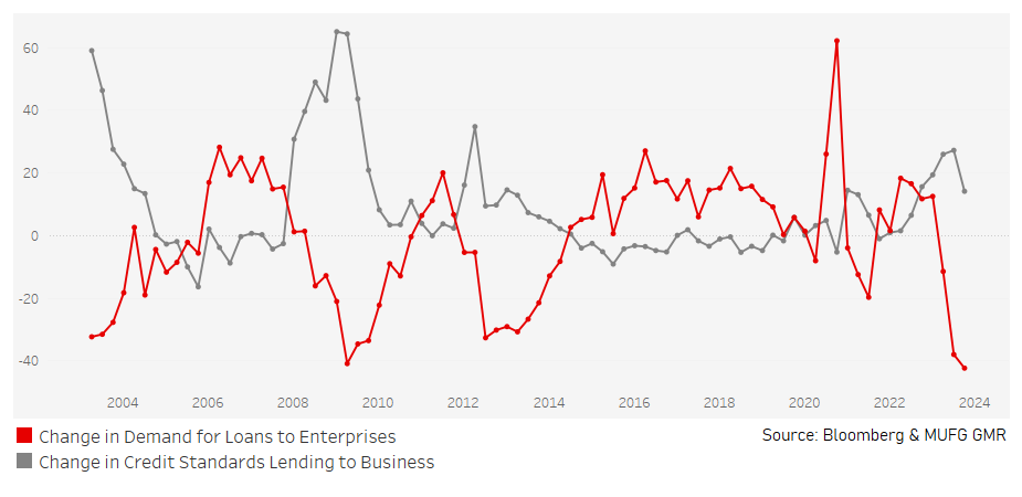
INFLATION VS. WAGE GROWTH
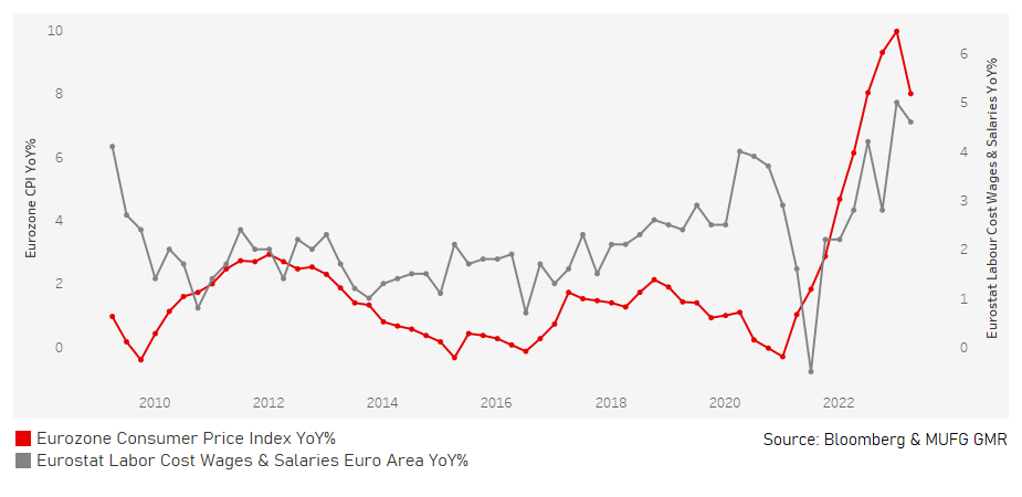
Pound Sterling
|
Spot close 31.07.23 |
Q3 2023 |
Q4 2023 |
Q1 2024 |
Q2 2024 |
|
|
EUR/GBP |
0.8573 |
0.8550 |
0.8650 |
0.8850 |
0.8900 |
|
GBP/USD |
1.2864 |
1.2870 |
1.2950 |
1.2770 |
1.2360 |
|
GBP/JPY |
182.84 |
177.50 |
176.10 |
171.10 |
163.10 |
|
Range |
Range |
Range |
Range |
||
|
GBP/USD |
1.2300-1.3300 |
1.2200-1.3400 |
1.2000-1.3300 |
1.1700-1.3000 |
MARKET UPDATE
In July the pound strengthened against the US dollar in terms of London closing rates from 1.2707 to 1.2864. The pound strengthened only very marginally against the euro, from 0.8588 to 0.8573. The BoE did not hold a policy meeting in July and the policy rate remained at 5.00%. The BoE commenced QT in November last year and implied in May that it could consider quickening the pace at some stage going forward.
OUTLOOK
The pound continued to strengthen in July hitting fresh year to date highs against the US dollar and euro. Cable hit an intra-day high of 1.3142 on 14th July and EUR/GBP hit an intra-day low of 0.8504 on 11th July. The stronger pound has been encouraged by the sharper adjustment higher in UK yields relative to in other major economies. While the ECB and Fed have signalled at their latest policy meetings in July that they are both close to the end of their hiking cycles, the BoE still has more work to do to feel confident that it can bring inflation back to their 2.0% target. The BoE’s policy rate is set to rise to a higher peak than the Fed later this year. We expect the BoE to revert back to delivering a more normal 25bps hike in August after hiking rates by 50bps at the last policy meeting in June. Pressure on the BoE to deliver back to back 50bps hikes has eased recently after the release of the weaker than expected UK CPI report for June. It brought an end to the run of four consecutive months of upside surprises for UK CPI reports which has brought some relief temporary relief for BoE policymakers and the UK bond market. It prompted the UK rate market to scale back expectations for the BoE’s terminal rate to a peak of between 5.75% and 6.00% down from closer to 6.50% in early July. The recent dovish repricing of BoE rate hike expectations has helped to dampen the pound’s upward momentum.
The recent dovish repricing of BoE rate hike expectations has also been triggered by the release of the weaker than expected UK PMI survey for July. The survey revealed that business confidence dropped back to 50.7 in July which is consistent with weaker growth at the start of Q3. It has cast some doubt on expectations for stronger growth in the 2H of this year supported by the ongoing easing of the cost of living crisis in the UK. Market participants are watching closely to assess how long the UK economy can withstand much higher rates. The increased prevalence of fixed rate mortgages is helping to delay the full negative impact of higher rates on the UK economy. We expect the pound’s outperformance so far this year to reverse as evidence builds of the negative fallout for the UK economy in the year ahead.
In these circumstances, we believe that the pound’s recent strong rebound is starting to lose some upward momentum. Evidence of much weaker UK growth in the 2H of this year and/or a faster than expected slowdown in inflation will be required to trigger a reversal of pound gains
INTEREST RATE OUTLOOK
|
Interest Rate Close |
Q3 2023 |
Q4 2023 |
Q1 2024 |
Q2 2024 |
|
|
Policy Rate |
5.00% |
5.50% |
5.50% |
5.50% |
5.00% |
|
1-Year Yield |
5.20% |
5.20% |
5.00% |
4.80% |
4.50% |
|
10-Year Yield |
4.31% |
4.40% |
4.30% |
4.10% |
3.90% |
* Interest rate assumptions incorporated into MUFG foreign exchange forecasts.
The 10-year Gilt yield decreased in July, by 8bps to close at 4.31%. Price action during the month was volatile. At the start of July, the Gilt market remained under selling pressure resulting in the 10-year yield hitting a fresh year to date high of 4.71% on 7th July as it briefly broke above the highs from last autumn during the negative fallout from the Liz Truss mini-budget. The 10-year Gilt yield has since fallen back and closed lower for July as a whole after the release of the weaker UK CPI report for June triggered a sharp correction lower for BoE rate hike expectations. After pricing in a peak for the BoE policy rate of around 6.50% in early July, market participants have since scaled those back to between 5.75% and 6.00%. It has helped to dampen upward pressure on long-term Gilt yields as well. While we believe that UK yields are moving closer to topping out, it is not as clear as in the euro-zone or US that the turning point has been reached. Inflation is proving more sticky in the UK and keeps pressure on the BoE to keep hiking rates in the 2H of this year.
HEADLINE VS. CORE INFLATION
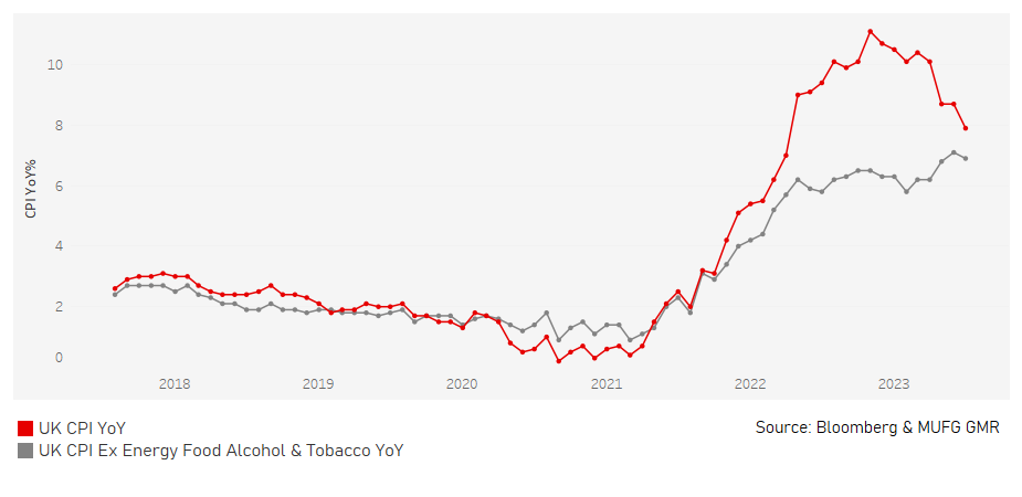
UK PMI SURVEYS
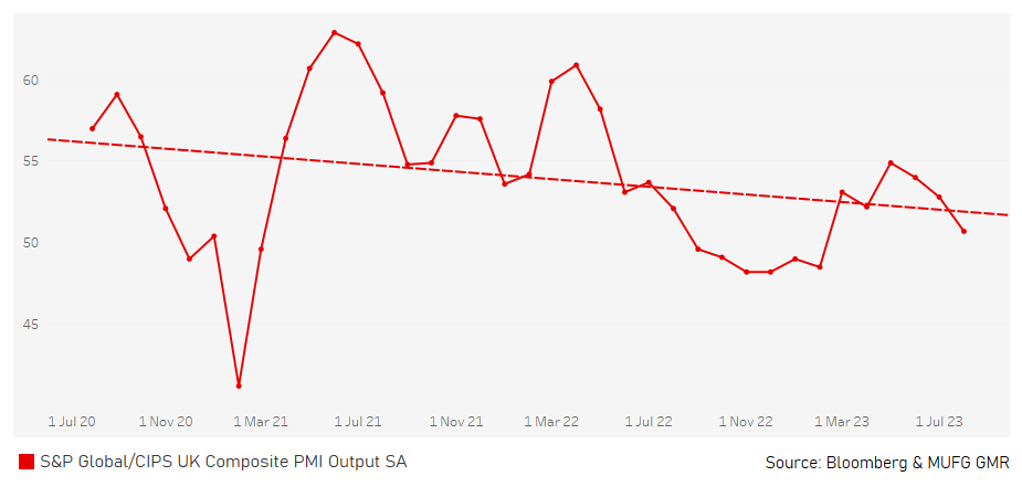
Chinese renminbi
|
Spot close 31.07.23 |
Q3 2023 |
Q4 2023 |
Q1 2024 |
Q2 2024 |
|
|
USD/CNY |
7.1440 |
7.0000 |
6.8000 |
6.7000 |
6.6000 |
|
USD/HKD |
7.7992 |
7.8000 |
7.7900 |
7.7800 |
7.7800 |
|
Range |
Range |
Range |
Range |
||
|
USD/CNY |
6.9500-7.3500 |
6.7000-7.2000 |
6.6000-7.1000 |
6.5000-7.0000 |
|
|
USD/HKD |
7.7600-7.8400 |
7.7500-7.8300 |
7.7400-7.8200 |
7.7400-7.8200 |
MARKET UPDATE
In July, the Chinese yuan appreciated by 1.4% against the US dollar to 7.1440, marking its first monthly gain since March. After keeping its 1-year MLF unchanged at 2.65% on 17th July, the PBOC on 20th July held its 1-year LPR and 5-year LPR steady at 3.55% and 4.20% respectively. More notably, the PBOC on 20th July raised its macro-prudential adjustment parameter (MPA) for cross-border financing for enterprises and financial institutions from 1.25 to 1.50, effective on 20th July 2023.
OUTLOOK
July was another month with weak economic data releases. June macro numbers implied persisting weak domestic demand. Although all major macro indicators expanded in June, retail sales expanded by a slower pace compared with May, measured by month-over-month change. And the mild expansion of IP was largely driven by mid- and upper- stream industries rather than down-stream industries, which raised concerns over the sustainability of the expansion. June data also showed private sector’s lack of confidence in economic prospects, as private FAI YTD contracted by 0.2%yoy in June, a much slower growth than overall FAI. Weak domestic demand and a -12.4% June export growth weighed on sentiment, but the yuan still strengthened moderately driven by: i) the weaker dollar & ii) portfolio inflows due to government’s continued efforts to support the economy and the yuan. Since late June, the PBOC has been setting a stronger-than-expected yuan fixing, and China has increased the macro-prudential adjustment parameter, a multiplier that decides the upper limit of outstanding cross-border financing available to an institution, from 1.25 to 1.5, according to a joint statement by the People's Bank of China and the State Administration of Foreign Exchange.
The Politburo meeting held on 24th July sent out positive messages, with the meeting making a clear judgment on the current situation, "domestic demand is insufficient", "there are many risks and hidden dangers in key areas", "the external environment is complex and severe" and etc, and government aiming to "increase the intensity of macro-policy regulation and focus on expanding domestic demand", "achieve effective improvement in quality and reasonable growth in quantity", and "strengthen counter-cyclical adjustment and policy reserves". The shift in tone toward the real estate market also signals further easing in the sector may come ahead. Additionally, the Politburo will continue to implement an active fiscal policy, pledging to accelerate the issuance and use of local government special bonds to spur investment, and effectively prevent and resolve local debt risks.
Potential implementation of the easing policy stances and gradual stabilization of the economic activity will help further strengthen the yuan against the US dollar in the medium-term. However, near term movements of USD/CNY can be volatile and subject to the worsening negative yield spread due to the PBOC’s easing while sentiment in China’s improving growth outlook is not yet solidified.
INTEREST RATE OUTLOOK
|
Interest Rate Close |
Q3 2023 |
Q4 2023 |
Q1 2024 |
Q2 2024 |
|
|
Loan Prime Rate 1Y |
3.55% |
3.40% |
3.40% |
3.40% |
3.50% |
|
MLF 1Y |
2.65% |
2.50% |
2.50% |
2.50% |
2.60% |
|
7-Day Repo Rate |
2.00% |
1.80% |
1.80% |
1.80% |
1.90% |
|
10-Year Yield |
2.67% |
2.55% |
2.70% |
2.75% |
2.80% |
* Interest rate assumptions incorporated into MUFG foreign exchange forecasts.
Judging from the situation in the first seven months of this year, the progress of the local government bond supply was behind the expectation, and the pace of government bonds supply was clearly slower than those of 2019 and 2022. We expect increased bond issuance through the remainder of this year. Additionally, the proposal by the Politburo meeting, “ effectively prevent and resolve local debt risks, and formulate and implement a package of debt reduction plans”, would imply issuing local government bonds to replace local implicit debts to extend thee debt repayment period and reduce the interest burden. Looking forward, despite the stronger supply, the under-allocation of financial institutions to the government bond and the normalizing of the allocation, and the potential further monetary easing in H2, mean that the demand for government bonds likely still is there, especially in near term. The yield of 10-year government bonds is expected to fall further before rising with alongside the improvement of outlook for economic activities. it may hit a low of 2.55% in near term
CHINA’S MANUFACTURING SECTOR CONTINUED TO CONTRACT IN JULY
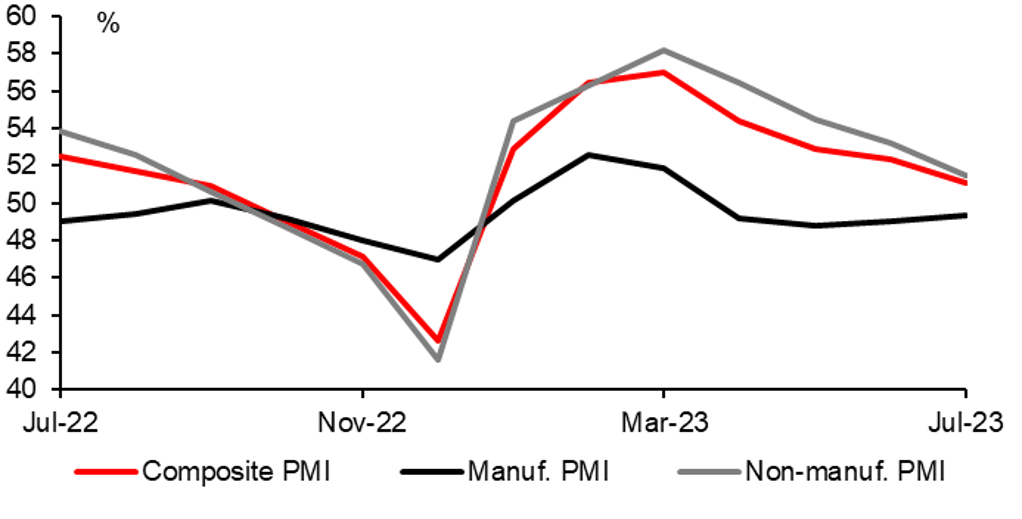
Source: CEIC, MUFG GMR
CHINA’S MANUFACTURING PMI REMAINED BELOW 50-MARK
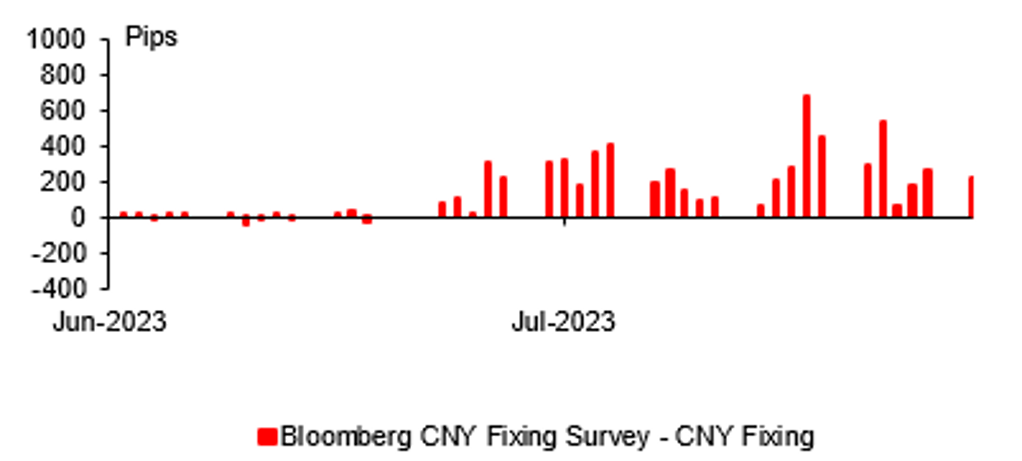
Source: Bloomberg, MUFG GMR

